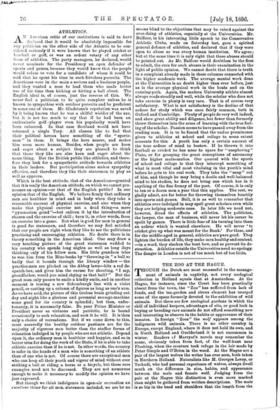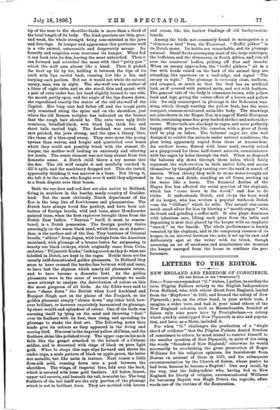THE ZOO AT THE HAGUE.
THOUGH the Thatch are most successful in the manage- ment of animals in captivity, not every zoological collection in Holland equals that at Amsterdam. At the Hague, for instance, since the Court has been practically absent from the town, the "Zoo" has suffered from lack of funds, and the tea-garden and circus element has usurped some of the space formerly devoted to the exhibition of wild animals. But there are few zoological gardens in which the skill of individual keepers, advantages of site, or good luck in buying or breeding rare animals do not afford something new and interesting to observe in the habits or appearance of their inmates. In foreign "Zoos" the wolf appears among the indigenous wild animals. There is no other country in Europe, except England, where it does not hold its own, and in North Holland and Guelderland it is not uncommon in winter. Readers cf Marryat's novels may remember the scene, obviously taken from fact, of the wolf-hunt near Flushing, when the creature took refuge in the lair made by Peter Simple and O'Brien in the wood. At the Hague are a pair of the largest wolves the writer has ever seen, both taken in Northern Holland. Naturalists like M. Georges Leroy, or Tschudi, who had personal experience of wolves, always dwell much on the difference in size, habits, and appearance between the male and female wolf. Judging from the pair at the Hague this distinction is even more marked than might be gathered from written descriptions. The male is so biz in the head and shoulders that the length from the tip of the nose to the shoulder-blade is more than a third of the total length of its body. The hind-quarters are thin, poor, and weak, the whole strength being concentrated in the jaws and fore-legs. In temper and appearance this particular wolf is a vile animal, untameable and desperately savage. Its ferocity and suspicion even overcome its hunger. When fed it ran back into its den, leaving the meat untouched. Then it ran forward and scratched the meat with that "privy paw" which the wolf uses almost like a hand. Then it picked the food up bit by bit, holding it between the tips of its teeth with lips curled back, running low like a fox, and burying each portion. But eat it would not while its natural enemy, man, was in sight. The she-wolf was the mother of a litter of eight cube, and as she stood, thin and gaunt, with s pair of cubs under her, her head slightly turned to one side, the mouth partly open, and the angle of the lips drawn down, she reproduced exactly the statue of the old she-wolf of the Capitol. Her long coat had fallen off, and the rough parts only remained along the spine and on the shoulders, just where the old Roman sculptor has indicated on the bronze that the rough hair should be. The cubs were ugly little creatures, brindled-black, with black lips, thick fur, and Mort tails carried high. The forehead was round, the ears pricked, the jaws strong, and the eyes a bleary blue, Like those of a blue-eyed sweep. They were more like young hyenas than wolves, and fought and quarrelled over bones which they could not possibly break with the utmost ill- temper, the mother wolf looking on anxiously and uttering low howls. The comic element was not long absent from this domestic scene. A Dutch child threw a toy mouse into the den. The old wolf caught it and carefully cracked it, till it split, and the machinery dropped out. This she tasted, apparently thinking it was marrow in a bone. Not liking it, he left it to the cubs, who fought over it until they adjourned to a fresh dispute over their bones.
Both the roe-deer and red-deer are also native to Holland, /lying in numbers in the heathy, sandy country of Guelder- land. But the most obviously Dutch department of the Zoo is the long line of fowl-houses and pheasantries. The Dutch have always loved fine poultry, and have been col- lectors of foreign breeds, wild and tame, since Hondecoeter painted them, when the first explorers brought them from the Dutch East Indies. " Bantam " itself, it must be remem- bered, is a Dutch possession. The foreign poultry thrive amazingly on the warm black sand, which here, as at Amster- dam, is the surface soil of the Zoo. Tiny bantams of Oriental breeds, " silkies " from Japan, wild turkeys from the American mainland, with plumage of a bronze lustre far surpassing in beauty our black turkeys, which originally came from Cuba, and even •• Plij month Rocks," looking much as they do when not labelled in Dutch, are kept in the cages. Beside them are the usually half-domesticated golden pheasants. In Holland they seem to have crossed the border-line between wild and tame, to have lost the shyness which nearly all pheasants retain, and to have become a domestic fowL As the golden pheasants were in the acme of summer plumage we made some attempt to analyse the distribution of colour on this Nile most gorgeous of all birds. As the Sikhs were said to liave "shone down" the British when Lord Auckland and Runjeet Singh met on the plains of the Panjanb, so the golden pheasant simply "shines down" any other bird, how- ever brilliant, or however exquisitely harmonised its plumage, by sheer wealth and splendour of colour. One of the birds was amusing itself by lying on the sand and throwing " dust " over its feathers with its foot, then rising and spreading its plumage to shake the dust out. The following notes then made give its colours as they appeared in the living and moving bird. His crest is the imperial yellow of China, and the feathers shine like polished ivory. The upper cape on his neck falls like the gorget attached to the helmet of a Chinese soldier, and is decorated with rings of black on pure light gold. When he stoops this cape slips forward and shows the sander cape, a scale pattern of black on apple-green, the latter not metallic, but like satin in texture. Next comes a little Loss-silk gold, running down into a peak between the -shoulders. The wings, of imperial blue, fold over the back, which is covered with loose gold feathers. All below, breast, aipper tail coverts, and beneath the tail, is scarlet inc. The long Gathers of the tail itself are the only portion of the plumage -which is not in brilliant hues. They are mottled with brown
and cream, like the leather bindings of old backgammon. boards.
Among the birds not commonly found in menageries is a "rhinoceros bird" from the Transvaal. " Buffel pikker " is its Dutch name. Its habits are remarkable, and its plumage unusual. Small flocks accompany most of the large antelopes, the buffaloes, and the rhinoceros, in South Africa, and run all over the creatures' bodies, picking off flies and insects. When an enemy approaches, the " buffel pikkers " sit in a line with heads raised on the back of the animal they are attending, like sparrows on a roof-ridge, and signal "The enemy in sight." The plumage is curiously close, uniform, and compact, so much so that the bird has an artificial look, as if covered with painted satin, and not with feathers. The general tint of the body is cinnamon-brown, with yellow beak and legs, giving the colour-effect of a brown and yellow iris. Its only counterpart in plumage is the Bohemian wax- wing, which, though wanting the yellow beak, has the same compact, cinnamon-coloured, satin-like body. The waxwings are also shown in the Hague Zoo, in a cage of North-European birds, containing some fine grey-backed shrikes and nutcracker crows. Water-rails are also kept in cages, and seem perfectly happy, sitting on perches like canaries, with a piece of fresh turf to play on below. The baboons' cages are also well designed to exhibit the animals under natural conditions, the plan being apparently copied from those at Amsterdam. An outdoor house, floored with loose sand, exactly suited as a playground for these half-desert animals, communicates with the cages by holes through the wall. When so disposed the baboons slip down through these holes, which fairly represent the rock-crevices in their native hills, and amuse themselves by thoughtfully turning over the sand in search of insects. When thirsty they walk to stone water-troughs set in the rune, and drink, standing on all fours, sucking up the water like a horse. The financial decline of the Hague Zoo has affected the social position of the elephant, which has "come down in the world," and has to do tricks. It understands Dutch, and obeys the least word of its keeper, who has written a popular work—in Dutch —on his " Olif ant," which he sells. The animal also earns mach small silver for him by blowing a " month-organ " with its trunk and grinding a coffee-mill. It also plays dominoes with laborious care, lifting each piece from the table and depositing it next that placed by the keeper with an emphatic "smack" on the boards. The whole performance is keenly resented by the elephant, and in the temporary absence of its keeper, in an interval between two acts, it set up its ears and deliberately spat at the writer with its trunk, though assuming an air of meekness and nonchalance the moment the keeper emerged from the house to continue the per- formance.



































 Previous page
Previous page